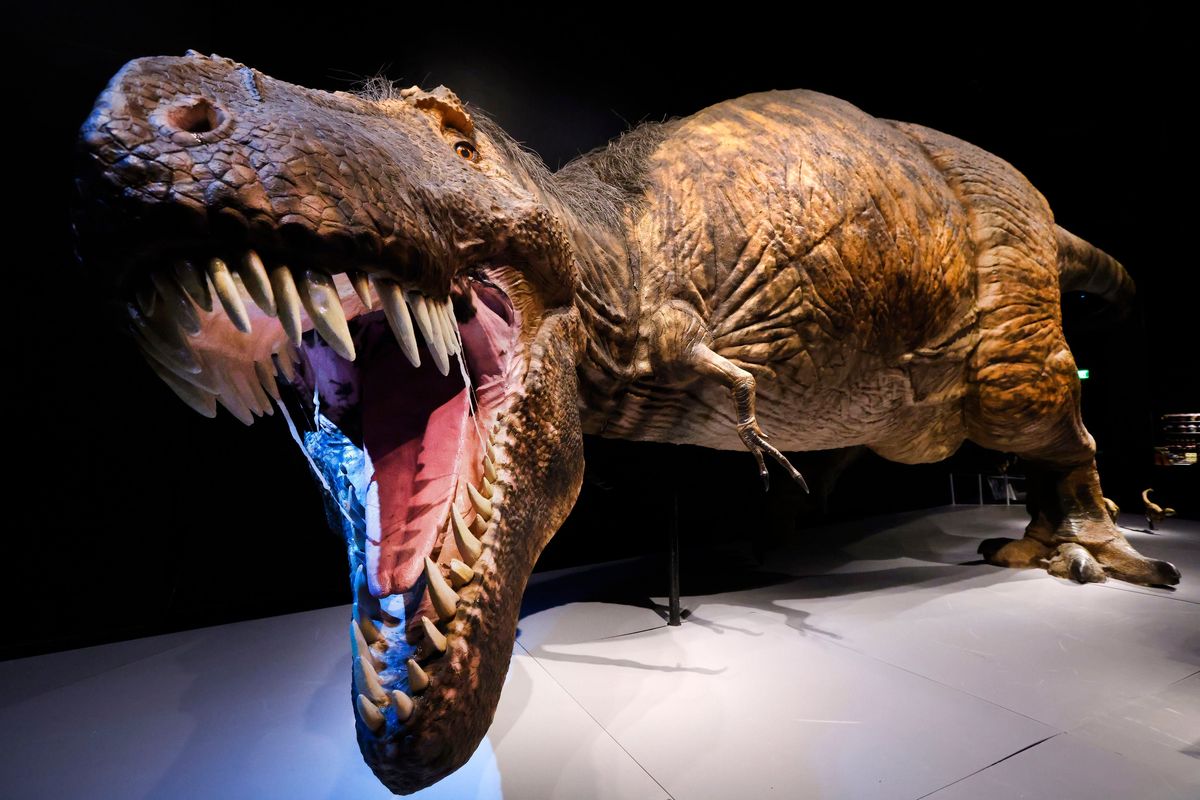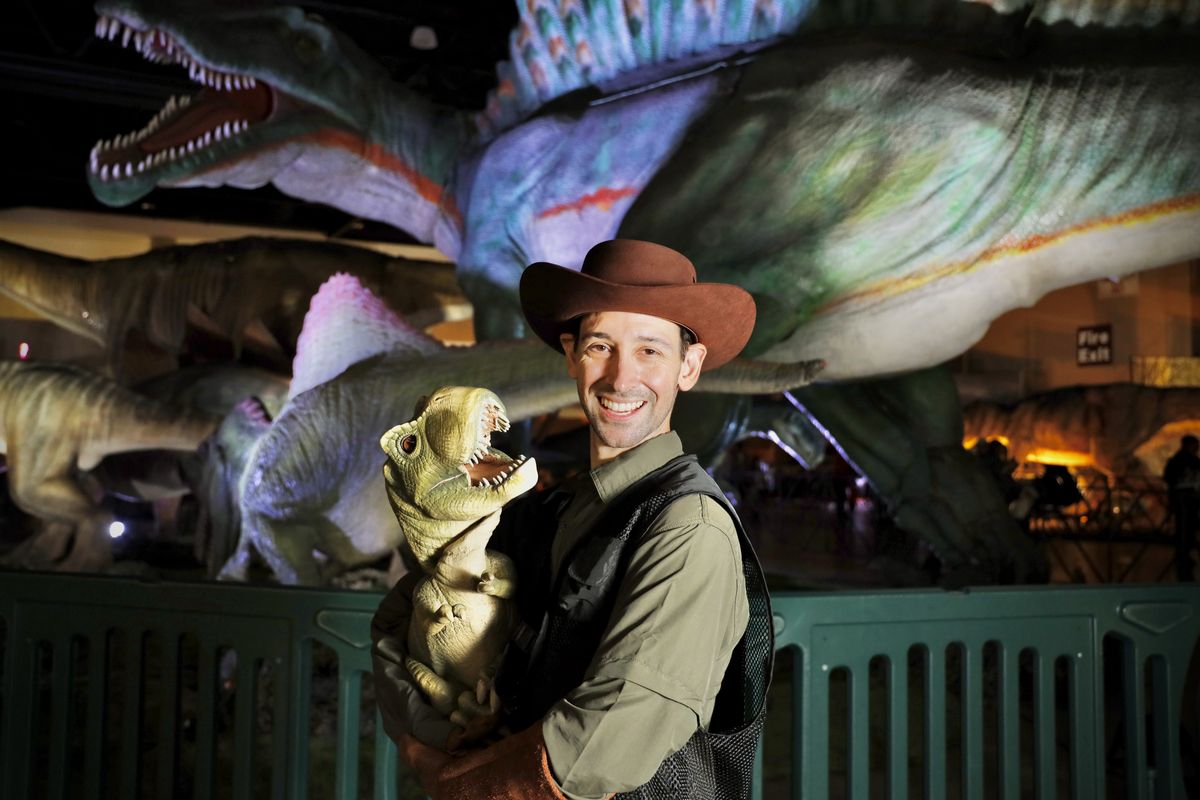Local biologists, professors discuss the kinds of dinosaurs still alive and well in our world, in preparation for Jurassic Quest event
A full-size replica of a Tyrannosaurus rex is on display at the Perot Museum of Nature and Science on Nov. 13 in Dallas. (Tom Fox/Dallas Morning News)
Dinosaurs: extinct, long gone. Right? Not so fast. Although some species of dinosaurs went extinct long ago, there are technically dinosaurs among us today in the form of our feathered friends, birds.
“I think my favorite dino fact is that they aren’t extinct,” said EWU assistant professor of biology, Charlotte Milling. “Technically, the birds you and I see today outside our windows and all over the world are dinosaurs. Makes you look at the neighborhood turkeys in a whole new light.”
If dinosaurs aren’t technically extinct, what’s the deal with the asteroid that wiped them out? To answer that, it’s helpful to know a little bit about the bigger picture of life on planet Earth.
Scientists estimate planet Earth to be 4.54 billion years old. Single-celled organisms, thought to be the earliest forms of life on Earth, emerged around 3.8 to 4 billion years ago. The process of photosynthesis is thought to have developed around 3 to 3.8 billion years ago.
Fast forward to about 535 million years ago and we arrive at what is called the “Cambrian Explosion.” This is a time in Earth’s history where many forms of new life appeared over the course of a few million years. This is also where we see the appearance of the first animals to have backbones, called vertebrates.
About 397 million years ago, some of the first animals with four legs began to develop, appropriately named tetrapods (tetrapod means “four legs” in Greek). Soon after, about 340 million years ago, came the first amphibians. A little later down the road, the tetrapods branch into two groups – reptiles, and “mammal-like” reptiles. Finally, around 250 million years ago, the first dinosaurs emerged.
The quantity of 3 billion years and 250 million years may feel a little meaningless. With a life span of just over 70 years, it’s hard for our human brains to imagine these vast spans of time. Enter a handy tool called the Cosmic Calendar. It condenses the estimated 13.8 billion year chronology of the universe into one single calendar year. The Big Bang is midnight of Jan. 1. Photosynthesis doesn’t arrive until October, and vertebrates don’t make an appearance until about Dec. 18.
In fact, December is quite a packed month. Amphibians arrive on the 22nd, reptiles the 23rd, dinosaurs the 25th, mammals the 26th and birds the 27th. On Dec. 30 comes that big asteroid – the Cretaceous–Paleogene extinction event. That is when our planet lost all nonavian dinosaurs. It is on the final day of the calendar, Dec. 31, at 11:52 p.m. that the first humans evolve.
Unlike what you may have seen in the Flintstones, Jacquelyn Belock, adjunct instructor of life sciences at Spokane Falls Community College assures us that wasn’t the case.
“Humans and nonavian dinosaurs never co-existed,” Belock said.
That isn’t to say we were not somewhat close on a cosmic scale.
“We are closer to the time of the last dinosaurs like T. rex and Triceratops than T. rex and Triceratops are to some other dinosaurs, like Stegosaurus,” Belock said.
Humans came 66 million years after the last dinosaurs, whereas later dinosaurs are 77 million years away from early dinosaurs like the Stegosaurus.
Bird is the word
What about those survivors whose ancestors have become a South Hill staple invasive species? The relatives of our modern day birds began long before the asteroid hit, in a family of dinosaurs called theropods. These dinosaurs were classified by their hollow bones and three-toed clawed feet with claws. Theropods were originally meat-eaters, and they share many traits with today’s birds – particularly the bird anatomy we see at Thanksgiving, the wishbone.
“The furcula (wishbone) in birds is present in all theropod dinosaurs in which a furcula has been found,” said Judd A. Case, professor of biology at Eastern Washington University.
Theropods are typically bipedal, walking on two feet. Perhaps the most iconic bipedal theropod are the mighty Tyrannosaurus rex, who despite being mighty, are often the butt of the joke due to their relatively tiny arms. It doesn’t take too much imagination to look at a T. rex and notice its similarities to a modern day bird.
“A T. rex is more closely related to a chicken than it is related to a Stegosaurus,” Belock said.
And it’s not just chickens who share these dinosaur relations. “Birds’ – from Archaeopteryx (a genus of avian dinosaurs) to hummingbirds – closest relatives are the raptors in the families Dromaeosauridae, Troodontidae and Unelagiidae, and all four groups form a larger, the Paraves,” Case said.
Paraves is a group that includes all dinosaurs closely related to birds.
“Early paravians were fully feathered, like birds, and were gliders. Later paravians became runners like raptors, had ‘protofeathers,’ which are filamentous feathers looking more like hair than modern bird feathers,” Case said.
Scientists are still trying to answer exactly how the Paraves survived the extinction event to become today’s birds, but they were so successful that there are now over 10,000 species of birds alive today.
Broaden your dino knowledge
There is much more to the story of dinosaurs, and luckily there are bountiful resources to help you gain a better understanding of these ancient life forms and how they are still a part of life today.
Jurassic Quest, which comes to the Spokane Convention Center Friday through Sunday, provides a fun event for young learners to get excited about dinosaurs. The traveling exhibit claims to showcase true-to-size models of dinosaurs, including the T. rex. Learn more about the event at Jurassicquest.com.
Spokane Public Library has a plethora of dinosaur books for every age. “Dinosaurs Dinosaurs,” by Bryon Barton showcases colorful depictions of dinosaurs that come in all sorts of shapes and sizes. “Dinosaurs: How They Lived And Evolved,” by Darren Naish and Paul Barrett dives deeper into the chronology of dinosaur life and the evidence paleontologists have to support our current understanding of how dinosaurs lived and evolved. “Dinosaurs: Fossils and Feathers,” by MK Reed and Joe Flood is a graphic novel that depicts the work of early paleontologists.
The dinosaur one area of biology that has sparked wonder for nearly all of us, and it’s never too late to discover more reasons to be fascinated by them and their role in the story of life on planet Earth.

